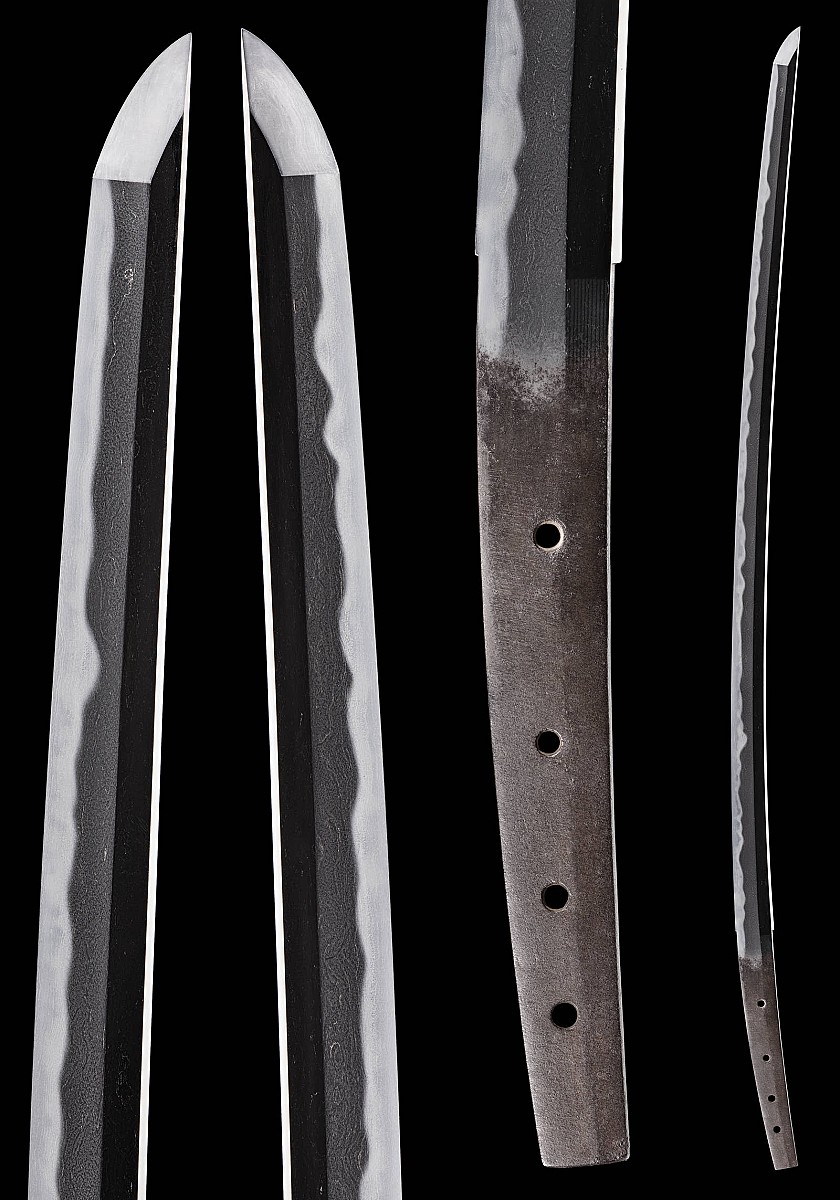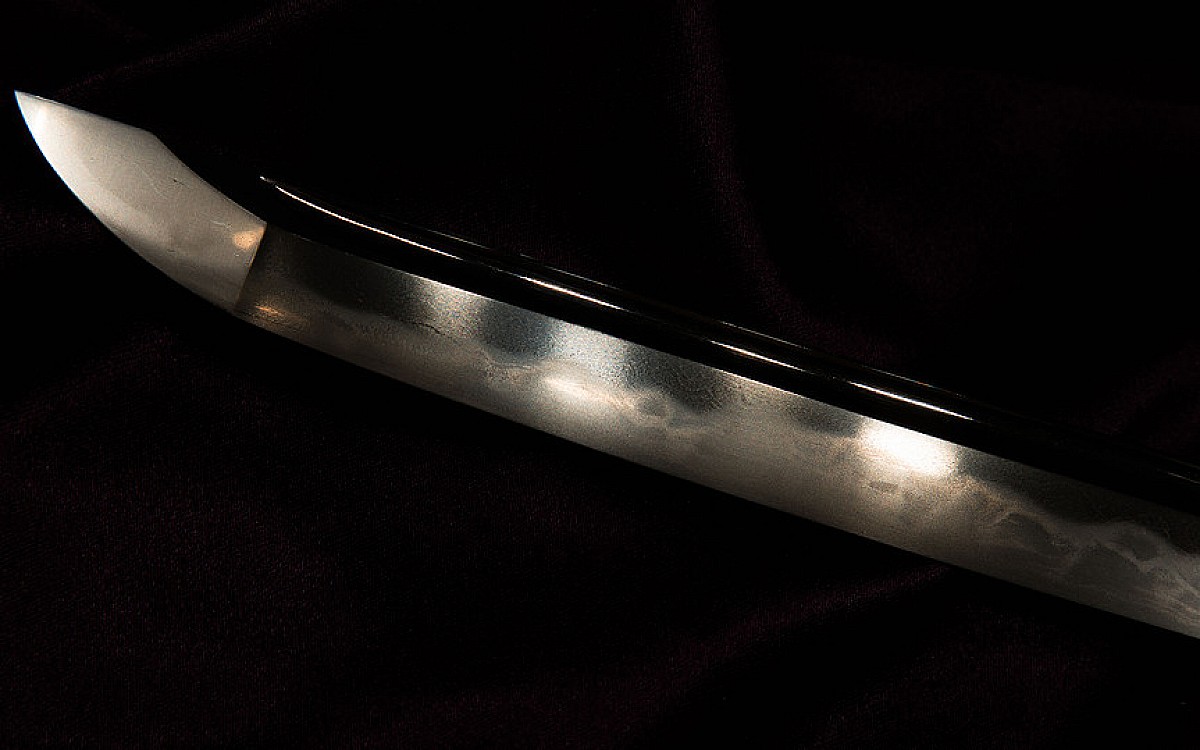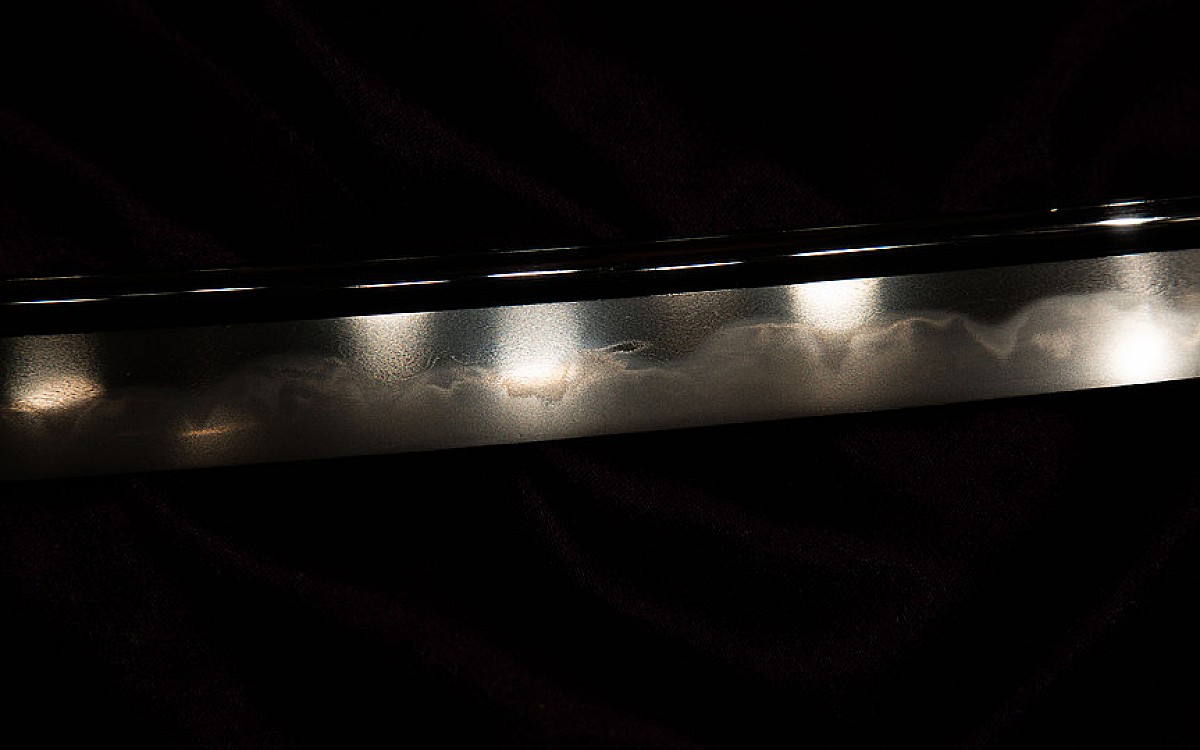Naotsuna (直綱), Kenmu (建武, 1334-1336), Iwami – „Naotsuna“ (直綱), „Naotsuna saku“ (直綱作), at birth, Naotsuna was given the name Kyū ́emon (久右衛門), according to old manuscripts he was a son of Moritsuna (盛綱), he lived in Iwami ́s Izuha (出羽) and is traditionally listed as one of the so-called Masamune no Jittetsu but a direct connection to Masamune is meanwhile denied by most of the experts, from the point of view of workmanship his blades looks like a mix of Sadamune, Shizu Kaneuji and Samonji, but they are somewhat inferior in quality. San ́indō (山陰道), jōjō-saku.
Jūyō Tōken Den Naotsuna Katana: nagasa: 72.4 сm; sori: 1.3 сm; motohaba: 2.9 сm; sakihaba: 1.9 cm; kissaki nagasa: 3.15 cm; nakago nagasa: 19.2 сm; nakago sori: 0.2 сm; without a signature, surge attributed as Den Naotsuna, sayagaki Kanzan Satō—January 1965 ). The sword is presented together with a authentic koshirae.
Designated as Jūyō Tōken at the 15th jūyō-shinsa held on the 10th of February 1967.
Publication: NBTHK Jūyō Tōken Nado Zufu, Volume 15.
I have always had a soft spot for Naotsuna. Whenever I see his work in good condition, it is spilling over with energetic activities and has been as impressive to me as Shizu. The difficulty ends up being finding a healthy one. Naotsuna's blades tend to have large nie grains which indicates a higher temperature during yaki-ire. In this case he has not made excessively large nie grains but the jihada is completely covered with dark chikei.
This sword came to me recently from Japan and it was love at first sight. The jigane is crystal clear featuring strong black chikei throughout the entire blade. These crisscross in and out of the hamon creating inazuma, and sunagashi inside. I find this blade to be very much like the work of Shizu and as well some Masamune. There is a longish kitae ware on the omote monouchi but the sword remains in very healthy condition and is stunning. It shows the connection to Masamune very well. The black ji nie and dark steel in fact could lead one to an attribution to Gō Yoshihiro or Norishige, except that the hamon pattern in this case seems to incorporate more gunome than would be normal for those smiths. Overall it feels to me like Gō or Norishige in the jihada mixed with Shizu in the hamon. The hamon itself is very bright and rich in Sōshū activities.
Not too long ago a Jūyō Naotsuna sold at Bonham's for and I had an opportunity to buy one of the Tokubetsu Jūyō Naotsuna (nidai) blades some years ago for $220,000. I think those prices are a bit expensive for Naotsuna but quality comes at a price.
I think this blade also matches very well with the last signed work of the Shodai. Both of these blades show a calm sugata that tapers, and similar activity in the jigane and hamon. However, this one is not signed, but is in better condition than the Tokubetsu Jūyō example. I think because of this late Kamakura work and the similarity with the shodai blade, that this is first generation Naotsuna.
It is accompanied by good quality black lacquered koshirae, featuring gold dragons and shakudo tsuba. The fuchi in particularly is beautiful and is signed Hamano Naohiro (kaō) 浜野直寛. The Hamano School is excellent, branching from Nara Toshinaga. I can't find out too much about this individual smith though I have seen other fine works by him online. I didn't try to paper this one and without a lot of references available, I can only say that I feel it will probably paper fine but try to make your own conclusion on the mei. It can be seen in the slideshow. The menuki and tsuba to me seem to be Waki-Gotō.
The entire blade is covered with ji nie that collect together into shiny dark chikei, making the attribution of this blade quite straight forward. The black chikei and nie activities nail the Sōshū origins of this blade as well as well make it clearly attributable to Naotsuna. I really love blades like this, with beautiful jihada and gorgeous activity everywhere. At just over 72 cm in length, it is also nicely premium sized. This blade as well passed Jūyō in the 1960s, before Tokubetsu Jūyō existed, making this the highest grade available at the time from the NBTHK.
It's getting harder and harder to find high quality Sōshū blades from the Nanbokucho and Kamakura periods. If you were looking to collect the Masamune Juttetsu, this would be an excellent example to fill the spot of Naotsuna.

Setsumei:
Katana, Mumei, Den Naotsuna
Keijo: shinogi-zukuri, iori-mune, shallow sori, chū-kissaki.
Kitae: itame that tends to nagare and that shows ji-nie.
Hamon: ko-notare in ko-nie-deki that is mixed with ko-gunome, togariba, ko-ashi and much sunagashi and that features a wide nioiguchi.
Bōshi: sugu-chō with hakikake.
Nakago: ō-suriage, shallow kurijiri, shallow katte-sagari yasurime, mumei.
Naotsuna was a swordsmith who lived in Izuha (出羽) in Iwami province. The first generation is said to have been a student of Masamune but this is hard to accept in terms of the different workmanship of the two smiths. This blade is ō-suriage mumei but as it shows an itame that tends to nagare and that displays ji-nie and hamon that is nie-based and mixed with gunome, togariba, and much sunagashi, there was agreement that the attribution should be to Naotsuna.
Sayagaki:
This sword bears a sayagaki from Dr. Satō Kanzan, one of the co-founders of the NBTHK and a 20th century scholar. This sayagaki is from 1965 and predates Jūyō which was in 1967 for this blade. Dr. Satō updated it to add the Jūyō information.

Dr. Satō Kanzan
1. 石州直綱 Sekishū Naotsuna;
2. 但大磨上無銘也 The blade is shortened and unsigned;
3. 重要刀剣指定 Designated as a Juyo Token;
4. 長七二糎六有之 nagasa 72.6 cm kore ari;
5. 昭和乙巳歳新春日 On a day in the first month of the year of the Snake of the Shōwa era (1965);
6. 寒山誌「花押」 Inscribed by Kanzan (kaō).
Author: Darcy Brockbank (published on www.yuhindo.com).
Edition: Dmitry Pechalov.








